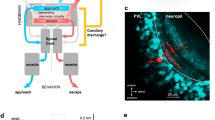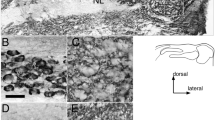Summary
We describe the cannulated Rana pipiens, tadpole preparation that allows for stable recording in the tectum of the extracellular potential elicited by optic nerve stimulation. The largest components of the evoked tectal response consist of two previously identified waves and a major third, long-latency wave of long duration. These components were reversibly eleminated by perfusion of high magnesium/no calcium Ringer's solution or Ringer's solution containing cobalt chloride. In contrast, perfusion of high calcium/no magnesium Ringer's increased the amplitude and area of these components. We conclude that these components represent post-synaptic activity.
Additionally, small, short-duration waves were identified as arising from the activity of retinal afferents. They consisted of a short-latency (3.1–7.6 ms) and a long-latency (12–23 ms) group. Waves belonging to both of these classes were still visible in both high magnesium/ no calcium Ringer's solution or Ringer's solution containing cobalt chloride and were unaffected by high calcium/no magnesium Ringer's. The average conduction velocities of the short- and long-latency groups matched the conduction velocities of, respectively, edge and convexity detectors in the adult. This indicates that retinal afferent input may already be present in adult patterns at the time that tectal circuitry is developing.
Similar content being viewed by others
Abbreviations
- TTX :
-
tetrodotoxin
- NMDA :
-
N-methyl-D-aspartate
- APV :
-
2-amino-5-phosphonovaleric acid
References
Ascher P, Nowak L (1986) Calcium permeability of the channels activated by N-methyl-D-aspartate (NMDA) in isolated mouse central neurones. J Physiol 377:43P
Ascher P, Nowak L (1988) The role of divalent cations in the N-methyl-D-aspartate responses of mouse central neurones in culture. J Physiol 399:247–266
Chung SH, Bliss TVP, Keating MJ (1974a) The synaptic organization of optic afferents in the amphibian tectum. Proc R Soc Lond B 187:421–447
Chung SH, Keating MJ, Bliss TVP (1974b) Functional synaptic relations during the development of the retino-tectal projection in amphibians. Proc R Soc Lond B 187:449–459
Cline HT, Constantine-Paton M (1989) NMDA receptor antagonists disrupt the retinotectal topographic map. Neuron 3:413–426
Cline HT, Debski EA, Constantine-Paton M (1987) N-methyl-D-aspartate receptor antagonist desegregates eye-specific stripes. Proc Natl Acad Sci USA 84:4342–4345
Constantine-Paton M (1982) The retinotectal hookup: the process of neural mapping. In: Subtelny S (ed) Developmental order: Its origin and regulation. Alan R Liss Inc, New York, pp 317–349
Currie J, Cowan WM (1974) Some observations on the early development of the optic tectum in the frog (Rana pipiens) with special reference to the early eye removal on mitotic activity in the larval tectum. J Comp Neurol 156:123–142
Debski EA, Cline HT, Constantine-Paton M (1987) Kynurenic acid blocks retinal-tectal transmission in Rana pipiens. Soc Neurosci Abstr 13:1691
Debski EA, Cline HT, Constantine-Paton M (1990) Activity-dependent tuning and the NMDA receptor. J Neurobiol 21:18–32
Del Castillo J, Engbaek L (1954) The nature of the neuromuscular block produced by magnesium. J Physiol 124:370–384
Dingledine R (1983) N-methylaspartate activates voltage-dependent calcium conductance in rat hippocampal pyramidal cells. J Physiol 343:385–405
Frankenhaeuser B, Hodgkin AL (1957) The action of calcium on the electrical properties of squid axons. J Physiol 137:218–244
Grant AC, Lettvin JY (1989) The nature of electrical transients recorded in frog tectal neuropil. Soc Neurosci Abstr 15:460
Grobstein P, Comer C (1983) The nucleus isthmi as an intertectal relay for the ipsilateral oculotectal projection in the frog, Rana pipiens. J Comp Neurol 217:54–74
Gruberg ER, Lettvin JY (1980) Anatomy and physiology of a binocular system in the frog Rana pipiens. Brain Res 192:313–325
Gruberg ER, Udin SB (1978) Topographic projections between the nucleus isthmi and the tectum of the frog Rana pipiens. J Comp Neurol 179:487–500
Hille B, Woodhull AM, Shapiro BI (1975) Negative surface charge near sodium channels of nerve: divalent ions, monovalent ions, and pH. Phil Trans R Soc Lond B 270:301–318
Hollyfield JG (1968) Differential addition of cells to the retina in Rana pipiens tadpoles. Dev Biol 18:163–179
Hubbard JI (1973) Microphysiology of vertebrate neuromuscular transmission. Physiol Rev 53:674–724
Kano M (1975) Development of excitability in embryonic chick skeletal muscle cells. J Cell Physiol 86:503–510
Karamian AI, Vesselkin NP, Belekhova MG, Zagorulko TM (1966) Electrophysiological characteristics of tectal and thalamo-cortical divisions of the visual system in lower vertebrates. J Comp Neurol 127:559–576
Katz B (1969) The release of neurotransmitter substances. Liverpool Univ Press, Liverpool
Krnjevíc K (1974) Chemical nature of synaptic transmission in vertebrates. Physiol Rev 54:418–540
Langdon RB, Manis PB, Freeman JA (1988) Goldfish retinotectal transmission in vitro: component current sink-source pairs isolated by varying calcium and magnesium levels. Brain Res 441:299–308
Lázár G (1984) Structure and connections of the frog optic tectum. In: Vanegas H (ed) Comparative neurology of the optic tectum. Plenum Press, New York, pp 185–210
Lettvin JY, Maturana HR, McCulloch WS, Pitts WH (1959) What the frog's eye tells the frog's brain. Proc Inst Radio Engrs 47:1940–1951
MacDermott AB, Mayer ML, Westbrook GL, Smith SJ, Barker JL (1986) NMDA receptor activation increases cytoplasmic calcium concentration in cultured spinal cord neurons. Nature 321:519–522
Maturana HR (1959) Number of fibres in the optic nerve and the number of ganglion cells in the retina of anurans. Nature 183:1406–1407
Maturana HR (1960) The fine anatomy of the optic nerve of anurans: an electron microscope study. J Biophys Biochem Cytol 7:107–120
Maturana HR, Lettvin JY, McCulloch WS, Pitts WH (1960) Anatomy and physiology of vision in the frog. J Gen Physiol (Suppl) 43:129–171
Mayer ML, Westbrook GL, Guthrie PB (1984) Voltage-dependent block by Mg++ of NMDA responses in sp cord neurones. Nature 309:261–263
McDonald JW, Cline HT, Constantine-Paton M, Margus WF, Johnston MV, Young AB (1989) Quantitative autoradiographic localization of NMDA, quisqualate and PCP receptors in the frog tectum. Brain Res 482:155–158
Merrill EG, Ainsworth A (1972) Glass-coated platinum-plated tungsten microelectrodes. Med Biol Eng 10:662–672
Nistri A, Sivilotti L (1985) An unusual effect of gamma-aminobutyric acid on synaptic transmission of frog tectal neurones in vitro. Br J Pharmacol 85:917–921
Nowak L, Bregestovskli P, Ascher P, Herbet A, Prochiantz A (1984) Magnesium gates glutamate-activated channels in mouse central neurones. Nature 307:462–465
Reh TA, Constantine-Paton M (1984) Retinal ganglion cell terminals change their projection sites during larval development of Rana pipiens. J Neurosci 4:442–457
Reh TA, Constantine-Paton M (1985) Eye-specific segregation requires neural activity in the three-eyed Rana pipiens. J Neurosci 5:1132–1143
Roberts PJ, Yates RA (1976) Tectal deafferentation in the frog: Selective loss of L-glutamate and gamma-aminobutyrate. Neurosci 1:371–374
Sarvey JM (1988) β-adrenergic mechanisms in long-term potentiation and norepinephrine-induced long-lasting potentiation. In: Woody CDE, Alkon DL, McGaugh JL (eds) Cellular mechanisms of conditioning and behavior plasticity. Plenum Press, New York, pp 65–76
Spitzer NC (1979) Ion channels in development. Annu Rev Neurosci 2:363–397
Spitzer NC (1980) The development of electrical excitability. In: Sears TA (ed) Neuronal and glial interrelationships. Springer, Berlin Heidelberg New York, pp 77–91
Steen P, Kalghatgi L, Constantine-Paton M (1989) Monoclonal antibody markers for amphibian oligodendrocytes and neurons. J Comp Neurol 289:467–480
Straznicky C, Gaze RM (1972) The development of the tectum in Xenopus laevis: An autoradiographic study. J Embryol Exp Morphol 28:87–115
Székely G, Lázár G (1976) Cellular and synaptic architecture of the optic tectum. In: Llinás R, Precht W (eds) Frog neurobiology. Springer, Berlin Heidelberg New York, pp 407–434
Taylor AC, Kollros JJ (1946) Stages in the normal development of Rana pipiens larvae. Anat Rec 94:7–23
Udin SB, Fawcett JW (1988) Formation of topographic maps. Annu Rev Neurosci 11:289–327
Author information
Authors and Affiliations
Rights and permissions
About this article
Cite this article
Debski, E.A., Constantine-Paton, M. Evoked pre- and post-synaptic activity in the optic tectum of the cannulated tadpole. J Comp Physiol A 167, 377–390 (1990). https://doi.org/10.1007/BF00192573
Accepted:
Issue Date:
DOI: https://doi.org/10.1007/BF00192573




